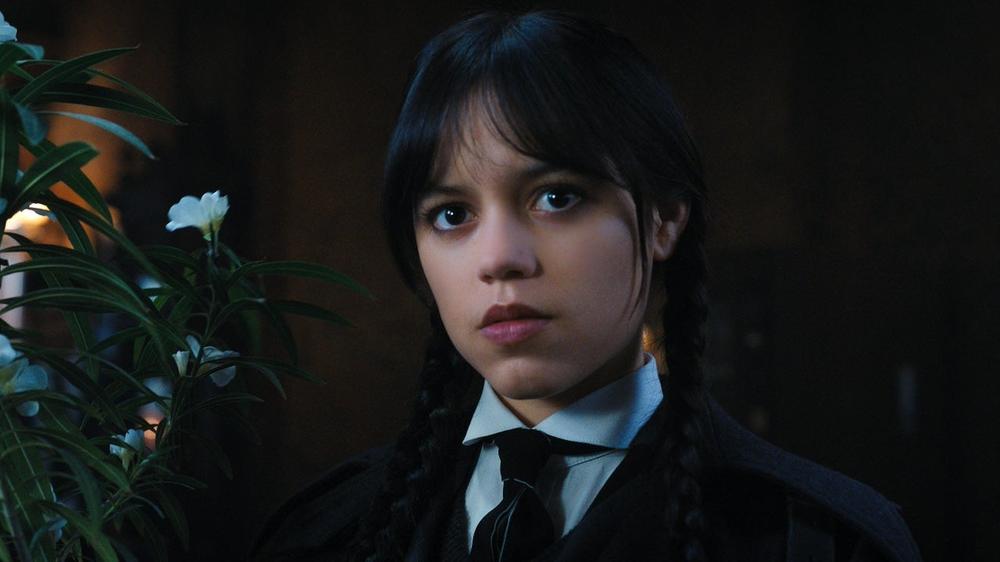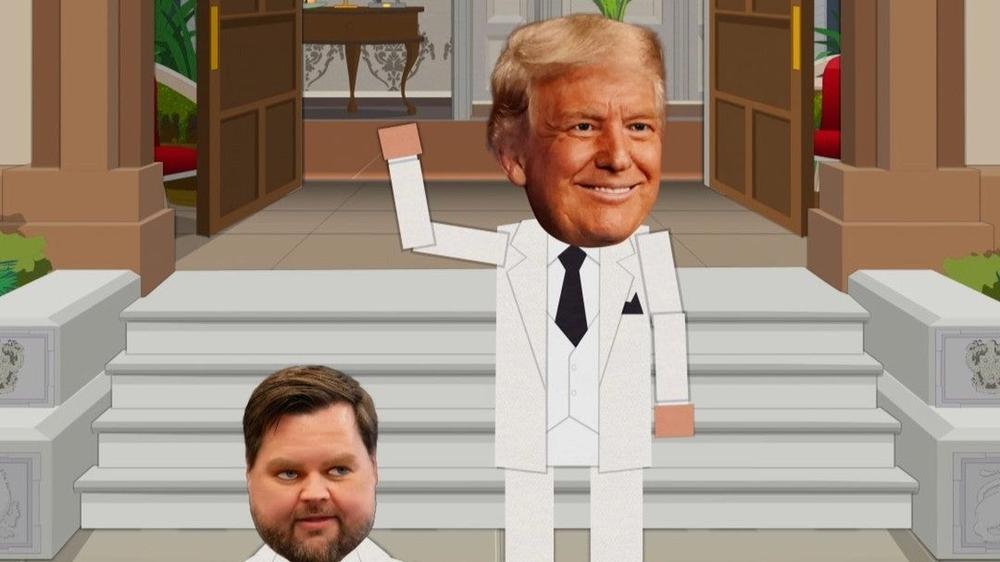This article contains spoilers for Wednesday Season 2… and Season 1, for that matter.
There are a few givens when you’re dealing with the Addams Family. They’re creepy and they’re kooky, of course; they can also be mysterious and spooky. They’re altogether ooky, but through two seasons (or at least a season and a half), Netflix’s Wednesday has failed these basic assignments. While the show is a gargantuan hit for the streamer, it’s one that completely misunderstands the source material, and continues to do so from the cold open of Season 2 onwards.
Created by Alfred Gough and Miles Millar, the Jenna Ortega star vehicle is based on the Addams Family characters created by cartoonist Charles Addams and initially appearing in The New Yorker starting in 1938. They’ve appeared on TV before, in movies, on stage, and even on pinball machines. The grim, grotesque, and hilarious extended Addams Family are as iconic in their own ways as Spider-Man, Batman, and the rest, recognized the world over in all their black-clad forms.
Other than the physical trappings, however, the characters on Wednesday are mostly unrecognizable to fans of the cartoons and movies thanks to a general softening of the premise to turn it into your run-of-the-mill supernatural school/mystery series. Instead of inhabiting the Addams’ dilapidated mansion, Wednesday (Ortega) is sent to Nevermore Academy, ostensibly Hogwarts for magical monsters with significantly less financial support for transphobic billionaires. There, Wednesday should be less of a weirdo and outcast given that everyone is weirdos and outcasts. But she wears black and white as opposed to the school’s purple and black (still pretty ooky if you ask us), and insists at every turn that she’s a weirdo. She does not, like Riverdale’s Jughead Jones (Cole Sprouse), wear a hat, but that’s about the level of weird she is on the show, which is to say, not that weird.
A Family That Slays Together
The main conflict of the series, other than monsters attacking the school for monsters and a general X-Men-esque hatred of the students by the normies in town, is between Wednesday and her mother, Morticia Addams (Catherine Zeta-Jones), seemingly only because Wednesday is grossed out by her mom loving her dad, though it might also be construed as general teen rebellion.
This, by the way, is fine. Part of the point of adaptation is that things are different and not direct reproductions of what’s come before. Gough and Millar are creating a version of the Addams Family that isn’t the 1960s sitcom; this one is built for 2020s streaming, complete with serialized plots and a little thing called character growth. You can’t have a character like Wednesday not grow in some form on a Netflix prestige series in 2025. This Wednesday, however, is so different from her New Yorker beginnings, and in particular from the Wednesday that appeared in the faithfully-adapted, Barry Sonnenfeld-directed Addams Family (1991) and Addams Family Values (1993), that the show is missing the point entirely.
As quoted in The Addams Family: An Evilution, a 2010 curated collection of 200 Addams cartoons, the creator laid it out pretty simply:
“Gomez and Pugsley are enthusiastic,” Addams noted. “Morticia is even in disposition, muted, witty, sometimes deadly. Grandma Frump is foolishly good-natured. Wednesday is her mother's daughter. A closely-knit family, the real head being Morticia – although each of the others is a definite character – except for Grandma, who is easily led. Many of the troubles they have as a family are due to Grandma's fumbling, weak character. The house is a wreck, of course, but this is a house-proud family just the same, and every trap door is in good repair. Money is no problem.”
While Ortega’s performance as Wednesday is clearly influenced by Christina Ricci’s deadpan rendition in the Sonnenfeld movies, there is generally zero enthusiasm to be had from the character, who would rather “nope” out of every situation to work on her novel or play her cello. It’s only through the addition of psychic precognition powers and the, yes, enthusiasm of her roommate Enid (Emma Myers) that Netflix’s Wednesday is compelled to do anything. She certainly barely tortures Pugsley, something they both enjoy in every other iteration of the Addams saga, and without the house, there can be no “proud of the house” plotlines. In fact, given how scattered the Addams Family is in Wednesday, there’s not a lot of love shown between them, either.
That’s the big emotional hole at the center of Wednesday, which it attempts to fill with the ENTIRELY PLATONIC relationship between the EXTREMELY STRAIGHT AND HETEROSEXUAL Wednesday and Enid, who BOTH HAVE MULTIPLE ROMANTIC INTERESTS WHO ARE MEN, OKAY? As for the family, instead of showing how in the midst of being the biggest weirdos in town, enjoying murder and torture and watching things die, the Addams Family still loves each other deeply, we get them bristling as they try to spend time together, far more interested in the legacy of Nevermore Academy than the other Addamses.
The darkly baroque humor of the comics is subsumed in quips and quirks, the hard edges softened for a more modern and presumably teen audience, who frankly can take the darkness and deserves better. But by sanding the edges off the property, Gough and Millar remove what makes the Addams Family unique. They are supposed to be all edge for the outside world, barbs and thorns and spikes; to each other, though, they express nothing but love, not through softness but through those same barbs and thorns and spikes, which they also love. It’s that dichotomy that fuels the laugh-out-loud nature of the best of the Addamses throughout the past 87 years.
Misunderstood Monsters
Interestingly, it’s the same sort of criticism that Addams himself lobbed at the ‘60s sitcom.
“Charles was up-and-down on the television show. He certainly enjoyed what The Addams Family did for his earning power, but he said the characters were ‘half as evil,’” said Addams biographer Linda H. Davis in an interview. “To be honest, he didn’t even really watch it, because on Friday nights he was usually out to dinner or on a date.”
If the characters were half as evil on The Addams Family sitcom, they’re not even a quarter evil on Wednesday; they’re objectively good. Chaotic good, sure, but that’s a 180-degree turn from where they’ve been depicted before.
Take, for example, the cold open of Wednesday Season 2. In it, we catch up with the title character on her summer break, where she’s spent time tracking down a serial killer she was obsessed with in her youth. So far, so true to the Addamses. Even allowing herself to be captured and tied up by the killer (played by Haley Joel Osment) is consistent with Wednesday’s character the way it was set out all those years ago. But what happens next decidedly is not.
Instead of asking for tips from the killer – as we all know, Wednesday loves murder – she gives him up to the cops to face justice. Sure, she shaves a head before she hands him over, but even that’s because he used human hair from his victims to create dolls. It’s not dark, it’s not whimsical, and it’s not weird. It’s exactly the sort of thing you would see any other supernatural avenger do, and it’s the same thing that happens over and over throughout the second season of Wednesday, as the character barely begrudges doing the right thing and helping out her friends.
This misunderstanding gets passed to the other characters as well, most notably Fester (Fred Armisen), who strikes up a romance with a lunch lady halfway through Season 2, Part 1, and then leaves her by telling her that of all the women he’s romanced, she was his favorite. There’s no joke there, no dark turn, just…he really liked her. And while a tango included in Season 2 nods to the razor-hot romance Morticia and Gomez (Luis Guzmán) exhibit in other versions of the Addams Family story, the two are mostly apart.
Full of Woe
What’s particularly disappointing about all this is that Tim Burton, one of the main creatives behind Wednesday, should be a perfect fit for the material. Burton almost single-handedly invented a generation of Hot Topic Goths thanks to Beetlejuice, Edward Scissorhands, The Nightmare Before Christmas, and more. And while a stop-motion sequence early in Season 2 finds that old Burton peeking through, his signature style is subsumed for the general blandness of the stores in the rest of the mall. Given that Burton was reportedly considered for the Sonnenfeld films, and Sonnenfeld was always considered to be chasing what Burton had, it’s wild that Sonnenfeld clearly got what the Addamses are about in a way that Burton and company have entirely missed. Heck, Burton flirted with a stop-motion version of the Addams Family that never came to be, so he’s clearly been thinking about this for years; instead, we got direction that might just as well be from Anonymous The CW Supernatural Series Director #2.
To get back to the point of adaptation, does all this really matter? Only in that there’s a reason the Addams Family has maintained its cultural impact for almost 90 years; of note, perhaps, to those who similarly think things have gone awry, the original New Yorker cartoons will enter the public domain in 2034. Wednesday presents less of the darkness in the character than that seen in the cartoons and movies, yes. But it also presents a lot less of the familial love and heart that infused prior iterations as well, showing weirdos that it is not just okay to be weird – it’s great, with the underlying message that you will find your people eventually, even if you’re into a little recreational murder and torture. Wednesday instead shows us the opposite – that the outliers need to join with everyone else to be truly happy. That’s neither creepy nor kooky nor mysterious and spooky; it’s just sad.

 South Park Season 27 Episode 'Got a Nut' Takes Aim at Trump's Mar-a-Lago Estate, JD Vance, and Kristi Noem
South Park Season 27 Episode 'Got a Nut' Takes Aim at Trump's Mar-a-Lago Estate, JD Vance, and Kristi Noem